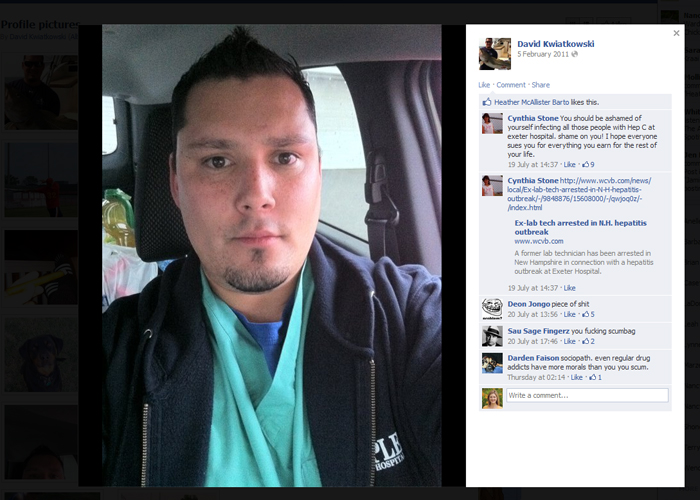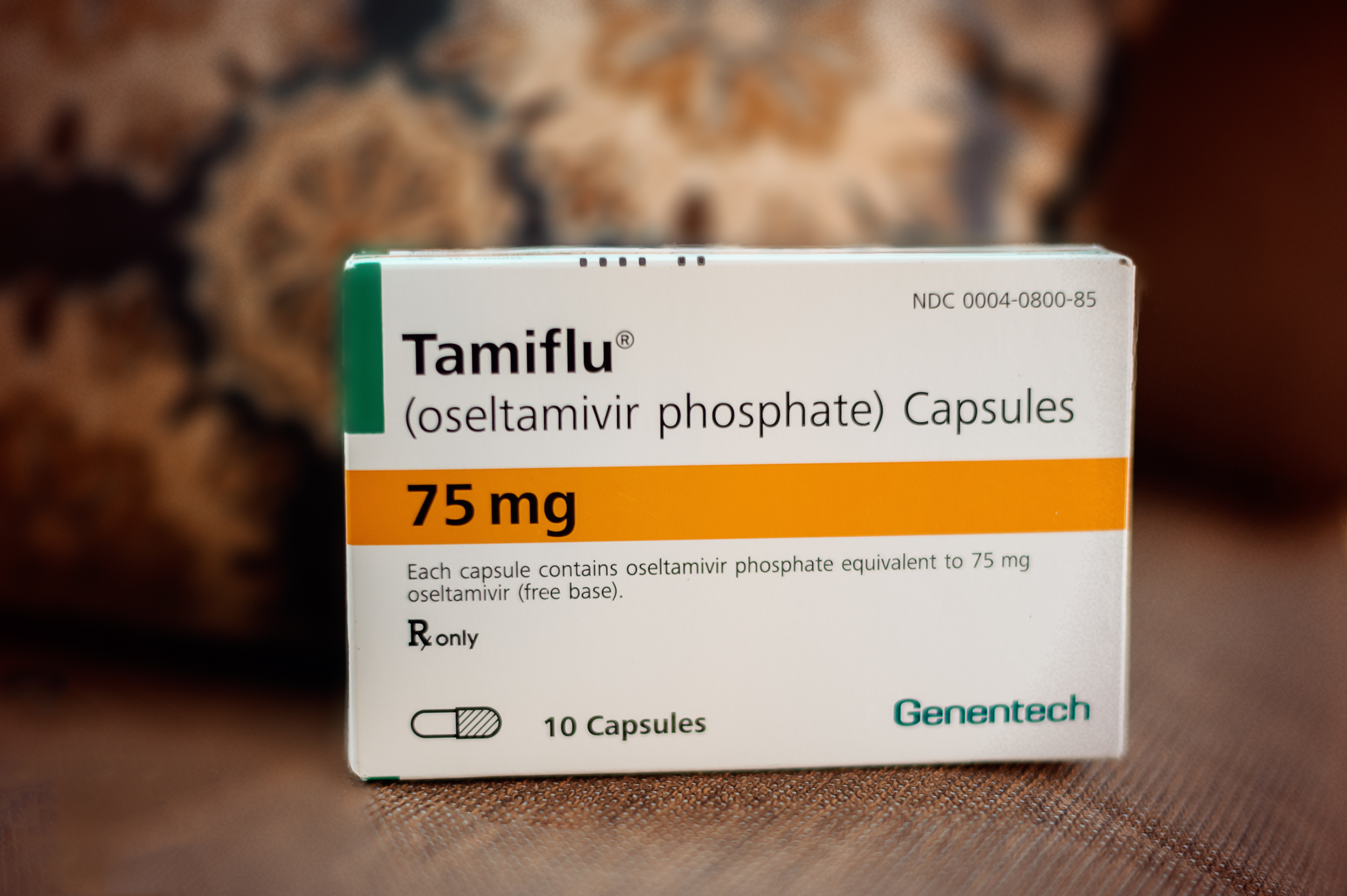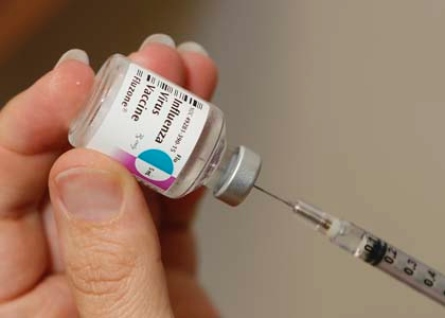 Exeter, NH – Exeter Hospital worker David Matthew Kwiatkowski, who officials say had hepatitis C and spread the disease to 30 unsuspecting patients by stealing drugs, has been arrested, the U.S. Attorney's office in New Hampshire announced Thursday.
Kwiatkowsi, 32, of Exeter, was arrested this morning at a hospital in Massachusetts, where he's receiving treatment for hepatitis C. He's charged with fraud and tampering.
Exeter, NH – Exeter Hospital worker David Matthew Kwiatkowski, who officials say had hepatitis C and spread the disease to 30 unsuspecting patients by stealing drugs, has been arrested, the U.S. Attorney's office in New Hampshire announced Thursday.
Kwiatkowsi, 32, of Exeter, was arrested this morning at a hospital in Massachusetts, where he's receiving treatment for hepatitis C. He's charged with fraud and tampering.
He faces up to 24 years in prison and a $250,000 fine.
That is it? A life sentence would be more appropriate. Let us delve into the world which is Hepatitis C. What future will these patients and any others that he so selfishly infected face?
Thomas Wharton, MD, FACC, medical director of the Cardiac Catheterization Unit at Exeter Hospital, now views Kwiatkowski as “the ultimate con artist and an extremely good cardiac technologist who pulled the wool over everyone's eyes.”
Of the isolated incidents that fellow Cardiac Catheterization Unit employees began reporting in the spring, Dr. Wharton said, “David had stories for everything that pulled at your heart-strings and we had no reason to disbelieve him. David claimed to have several important medical conditions, and we had no reason to challenge this. The day he reportedly arrived to work with red eyes he told us his aunt had died the night before and he had been up all night crying.”
And the kicker really is his response to investigators about the people he spread the virus to:
"You know, I'm more concerned about myself, my own well being," he told investigators. "That's all I'm really concerned about and I've learned here to just worry about myself and that's all I really care about now."
From http://www.epidemic.org:
Although few prospective long-term survival and health care cost studies are available for hepatitis C, it has been possible to estimate the life-long economic impact of the disease for both the individual patient and for the U.S. population with chronic hepatitis B. Lifetime health care costs for a patient with chronic hepatitis B has been estimated at $65,000 in the absence of liver transplantation. For the 150,000 HBV carriers with significant liver damage, the lifetime health care costs in the U.S. have been estimated to be $9 billion. Assuming an estimated survival of 25 years, the annual health care costs for the affected U.S. population with chronic hepatitis B is $360 million. Based on the same economic analysis, treatment of chronic hepatitis B with interferon is projected to increase life expectancy by about three years and cut the total health care costs.
Hepatitis C can only represent a far greater economic cost. While it infects about 3 and a half more times as many people in the United States than does hepatitis B, more than 80% of hepatitis C patients will develop chronic liver disease, as compared to only 20% of hepatitis B patients. Limited data suggest that 15-20% of those with chronic hepatitis C will develop cirrhosis within a five-year period, and as many as 25% may have cirrhosis by 10-20 years. The risk of developing liver cancer is uncertain, but may approach or exceed 1% during the first 20 years of infection and increase afterwards. Hepatitis C is responsible for about one-third of all liver transplants in the United States.
Approximately 1,000 patients are transplanted each year for liver disease due to hepatitis C. With the cost per liver transplantation in the range of $280,000 for one year, liver transplantation for hepatitis C alone reaches a cost of nearly $300 million per year.
Moreover, the average lifetime cost for hepatitis C, in the absence of liver transplant, has been estimated to be about $100,000 for individual patients. Assuming that 80% of the 4.5 million Americans believed to be infected develop chronic liver disease, the total lifetime cost for this group (3.6 million) will be a staggering $360 billion in today's dollars. Assuming an estimated survival of 40 years, the annual health care costs for the affected U.S. population with chronic hepatitis C may be as high as $9 billion.
It would be prudent to consider that every single person that he has infected would at the VERY least receive $100,000 up front PLUS the cost of transplant and the cost of the emotional toll. He should never be able to walk in society again and spend the rest of his time working to pay this debt.
I also believe that the hospital should cover the rest of the cost considering the signs were there for him being under the influence. All it would have taken would be ONE person, ONE coworker, ONE physician to take the chance and get this guy tested. Also, pharmacists should have a bigger role in a cath lab like this to prevent nurses and staff from having such access to be able to hide something like this. I'm just appalled at this man's evil behavior coupled with the lack of safe policy at the hospital(s) in question.
This is just my opinion.
 If the commercially prepared oral suspension is not available, the manufacturer provides the following compounding information to prepare a 6 mg/mLsuspension in emergency situations.
If the commercially prepared oral suspension is not available, the manufacturer provides the following compounding information to prepare a 6 mg/mLsuspension in emergency situations.





